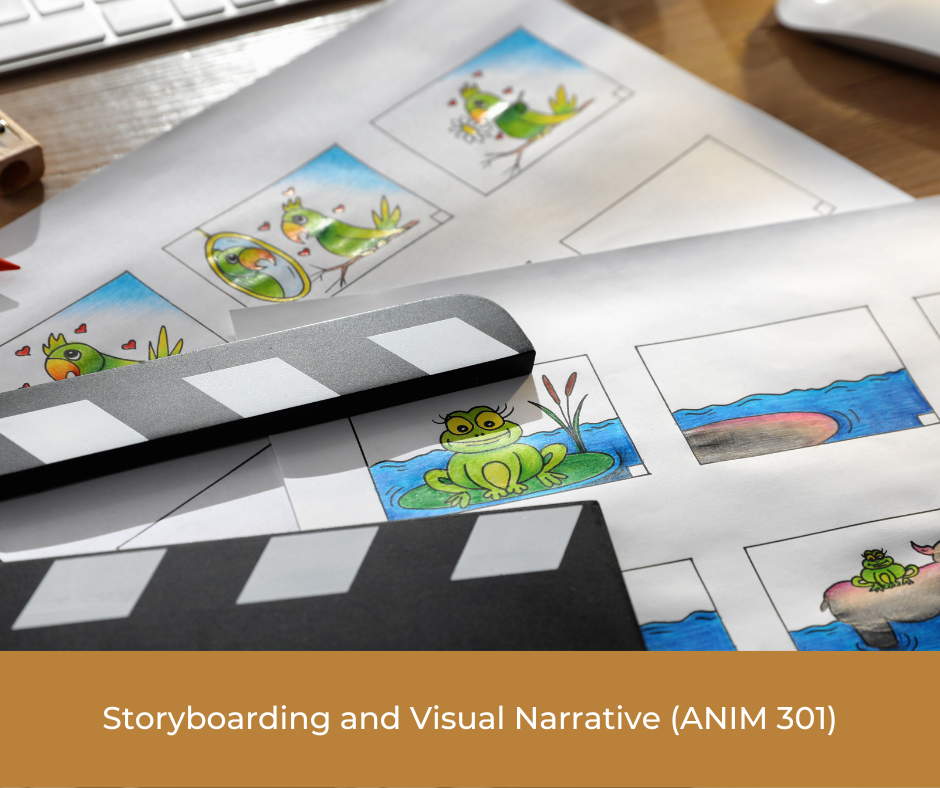Your cart is currently empty!
Storyboarding and Visual Narrative (ANIM 301)

Course Description
Storyboarding and Visual Narrative (ANIM 301) is a course that delves into the art of visual storytelling through the medium of storyboarding. This course equips students with the skills to create captivating narratives, plan sequences effectively, and transform ideas into visually compelling scripts. Students will explore the principles and techniques of storyboarding used in animation, film, and other visual storytelling mediums.
Outline of Major Content Areas
- Introduction to Storyboarding: An overview of the history and importance of storyboarding in visual storytelling.
- Storyboarding Basics: Fundamentals of storyboarding, including terminology, composition, and shot types.
- Script Analysis: Analyzing scripts and narratives to identify key scenes, character development, and pacing.
- Storyboard Creation: Step-by-step guidance on creating storyboards, from initial sketches to finalized panels.
- Visual Storytelling Techniques: Techniques for conveying mood, emotion, and action through visual storytelling.
- Sequencing and Timing: Understanding the flow of sequences and timing in storyboards.
- Narrative Structure: Developing narrative structures, including plot arcs, character arcs, and conflict resolution.
- Storyboarding for Different Mediums: Adapting storyboarding techniques for animation, film, and other media.
Course Learning Outcomes
Upon completing Storyboarding and Visual Narrative (ANIM 301), students will:
- Storyboarding Proficiency: Develop proficiency in creating storyboards for visual narratives, understanding composition and shot types.
- Script Analysis: Analyze scripts and narratives to identify key scenes, character development, and pacing.
- Visual Storytelling Skills: Demonstrate the ability to convey mood, emotion, and action effectively through visual storytelling.
- Narrative Structure: Create storyboards that adhere to narrative structures, including plot arcs and character development.
- Sequencing and Timing: Understand the importance of sequencing and timing in visual storytelling.
- Adaptation for Different Mediums: Adapt storyboarding techniques for various mediums, including animation and film.
Methods for Assessing Student Learning
Assessment in Storyboarding and Visual Narrative (ANIM 301) incorporates practical assignments and project-based evaluations to gauge students’ understanding and application of storyboarding principles. Assessment methods include:
- Storyboard Projects: Evaluation of storyboard projects, including the creation of storyboards for specific scenes or narratives.
- Script Analysis: Assessment of students’ ability to analyze scripts and identify key elements for storyboarding.
- Visual Storytelling Assignments: Review of visual storytelling assignments, focusing on conveying mood, emotion, and action effectively.
- Narrative Structure Assessment: Evaluation of storyboards for adherence to narrative structures, including plot and character development.
- Sequencing and Timing: Assessment of sequencing and timing in storyboards, ensuring an understanding of pacing.
Storyboarding and Visual Narrative (ANIM 301) equips students with essential skills for crafting engaging visual narratives. By the end of the course, students will have a strong foundation in storyboarding techniques, allowing them to contribute effectively to animation, film, and other visual storytelling projects.